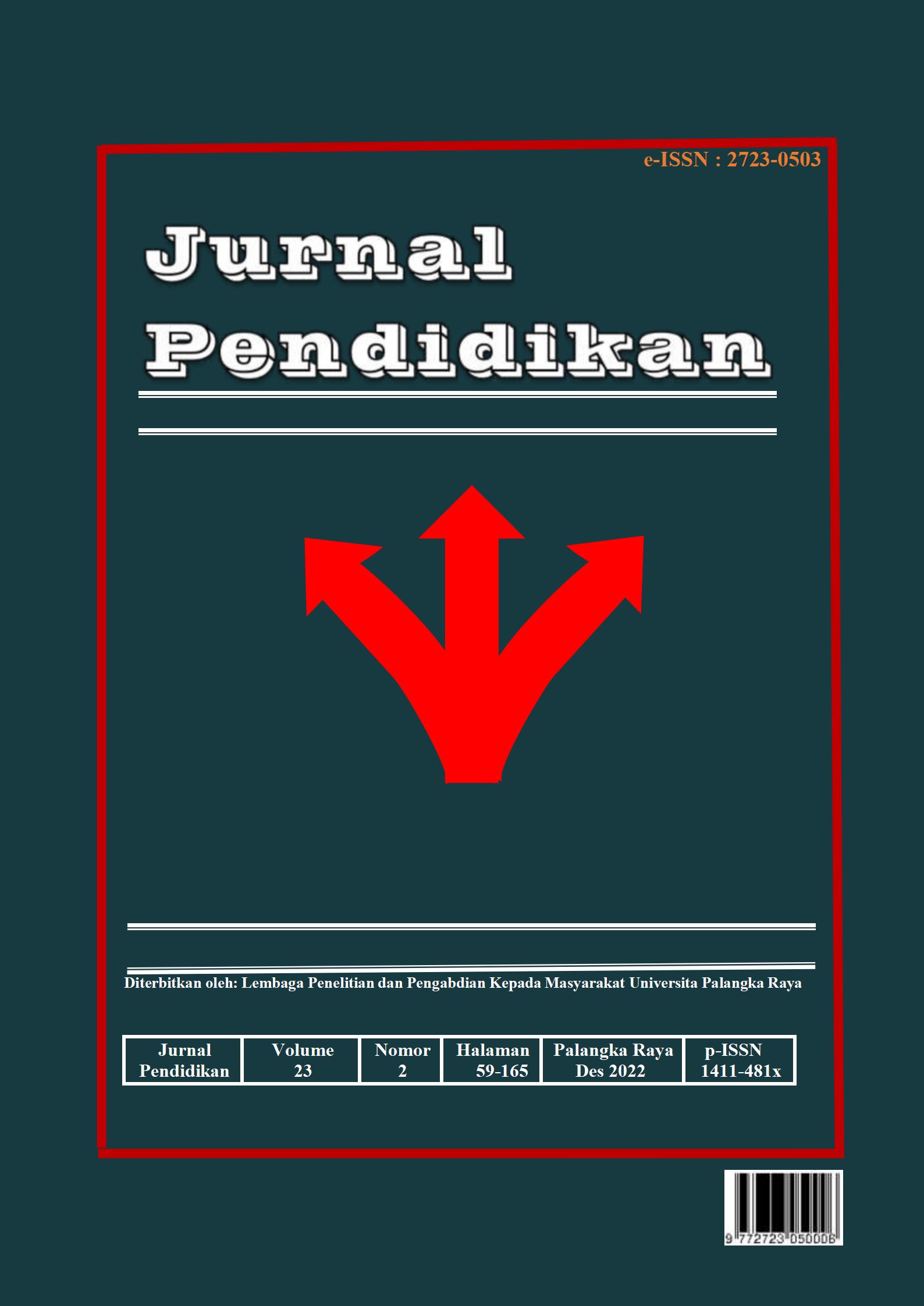Pengaruh Implementasi Problem-Based Learning (PBL) Terhadap Pembelajaran Procedural Text Dan Berpikir Kritis Di Kelas VIII SMP Nusantara Palangka Raya
DOI:
https://doi.org/10.52850/jpn.v23i2.5221Kata Kunci:
problem-based learning, procedural text, critical thinkingAbstrak
Model pembelajaran inovatif Problem Based Learning (PBL) akan diterapkan untuk mengatasi permasalahan yang dihadapi siswa kelas VIII SMP Nusantara Palangka Raya. Permasalahannya adalah kurangnya kemampuan siswa dalam memahami teks prosedur dan kurangnya kemampuan siswa untuk berpikir kritis. Penelitian ini merupakan penelitian eksperimen dengan desain pre-test->treatment->post-test. Instrumen yang digunakan untuk mengumpulkan data adalah wawancara, angket, dan tes. Analisis data menggunakan SPSS.
Hasil penelitian menunjukkan terdapat peningkatan yang signifikan dari variabel pretest ke variabel posttest setelah mendapat perlakuan, (pretest M = 69,1, SD = 5,527; posttest M = 88,1, SD = 8,478; t(9)=-13.217, p=.000). Kemudian nilai koefisien korelasi atau korelasinya sebesar 0,872 dengan nilai sig. 0,001. Hasil uji sampel berpasangan menunjukkan nilai Sig. (2-tailed) adalah 0,000, dan nilai Mean Paired Difference adalah -19.000. Karena Ha diterima, maka hasil tersebut menunjukkan bahwa terdapat peningkatan pemahaman teks prosedur melalui penerapan model PBL dan keterampilan berpikir kritis siswa kelas VIII SMP Nusantara Palangka Raya. Oleh karena itu, penelitian ini merekomendasikan penerapan PBL untuk meningkatkan kinerja siswa.
Unduhan
Referensi
Amalia, E., Surya, E., & Syahputra, E. 2017. The effectiveness of using problem-based learning (PBL) in mathematics problem-solving ability for junior high school students. International Journal of Advanced Research and Innovative Ideas in Education, 3(2), 3402–3406.
Andini, S., & Hobri., S. 2017. Students’ activity in problem-based learning (PBL) math classrooms is oriented to lesson study for the learning community (LLC). International Journal of Advanced Research, 5(9), 1395–1400. https://doi.org/10.21474/IJAR01/5458
Barret, T. 2017. A New Model of Problem–Based Learning. AISHE: The All Ireland Society for Higher Education.
Firdaus, F., Kailani, I., Bakar, Md. N. bin, & Bakry, B. 2015. Developing Critical Thinking Skills of Students in Mathematics Learning. Journal of Education and Learning (EduLearn), 9(3), 226–236. https://doi.org/10.11591/edulearn.v9i3.1830
Karyatin, K. 2017. Penerapan Modified Problem Based Learning (PBL) Dengan Gallery Walk (Gw) Untuk Meningkatkan Keterampilan Menyusun Peta Pikiran Dan Hasil Belajar Ipa. Jurnal Penelitian Pendidikan IPA, 1(2), 42. https://doi.org/10.26740/jppipa.v1n2.p42-51
Kassab, S. E., Hassan, N., El-Araby, S., Salem, A. H., Alrebish, S. A., Al-Amro, A. S., Al-Shobaili, H. A., & Hamdy, H. 2017. Development and Validation of the Motivation for Tutoring Questionnaire in Problem-Based Learning Programs. Health Professions Education, 3(1), 50–58. https://doi.org/10.1016/j.hpe.2017.03.001
Khoiriyah, A. J., & Husamah, H. 2018. Problem-based learning: Creative thinking skills, problem-solving skills, and learning outcome of seventh-grade students. JPBI (Jurnal Pendidikan Biologi Indonesia), 4(2), 151–160. https://doi.org/10.22219/jpbi.v4i2.5804
Mutakinati, L., Anwari, I., & Kumano, Y. 2018. Analysis of Students’ Critical Thinking Skill of Middle School through STEM Education Project-Based Learning. Jurnal Pendidikan IPA Indonesia, 7(1), 54–65. https://doi.org/10.15294/jpii.v7i1.10495
Pujiriyanto. 2019. Peranan Guru Dalam Pembelajaran Abad 21: Vol. Modul 2.
Rusman. 2016. Model-Model Pembelajaran. PT. Raja Grafindo Persada.
Santoso, S. 2014. Panduan Lengkap SPSS versi 20 edisi revisi. PT. Elex Media Komputindo.
Şendağ, S., & Ferhan Odabaşı, H. 2009. Effects of an online problem-based learning course on content knowledge acquisition and critical thinking skills. Computers & Education, 53(1), 132–141. https://doi.org/10.1016/j.compedu.2009.01.008
Strobel, J., & van Barneveld, A. 2009. When is PBL More Effective? A Meta-synthesis of Meta-analyses Comparing PBL to Conventional Classrooms. Interdisciplinary Journal of Problem-Based Learning, 3(1). https://doi.org/10.7771/1541-5015.1046
Sugiyono. 2017. Metode Penelitian Pendidikan: Pendekatan Kuantitatif, Kualitatif, dan R&D) . Alfabeta.
Supiyandi, M. I., & Julung, H. 2016. Pengaruh model problem based learning (PBL) terhadap kemampuan memecahkan masalah dan hasil belajar kognitif siswa biologi SMA. Jurnal Pendidikan Sains, 4(2), 60–64.
Surya, E., & Syahputra, E. 2017. Improving High-Level Thinking Skills by Development of Learning PBL Approach on the Learning Mathematics for Senior High School Students. International Education Studies, 10(8), 12. https://doi.org/10.5539/ies.v10n8p12
Trianto. 2019. Mendesain Pembelajaran Inovatif-Progresif. Kencana Prenanda Media Group.
Ulger, K. 2018. The Effect of Problem-Based Learning on the Creative Thinking and Critical Thinking Disposition of Students in Visual Arts Education. Interdisciplinary Journal of Problem-Based Learning, 12(1). https://doi.org/10.7771/1541-5015.1649
Unduhan
Diterbitkan
Cara Mengutip
Terbitan
Bagian
Lisensi
Hak Cipta (c) 2022 Ristati, Maida Norahmi, Novika Amalia

Artikel ini berlisensi Creative Commons Attribution-NonCommercial-NoDerivatives 4.0 International License.





